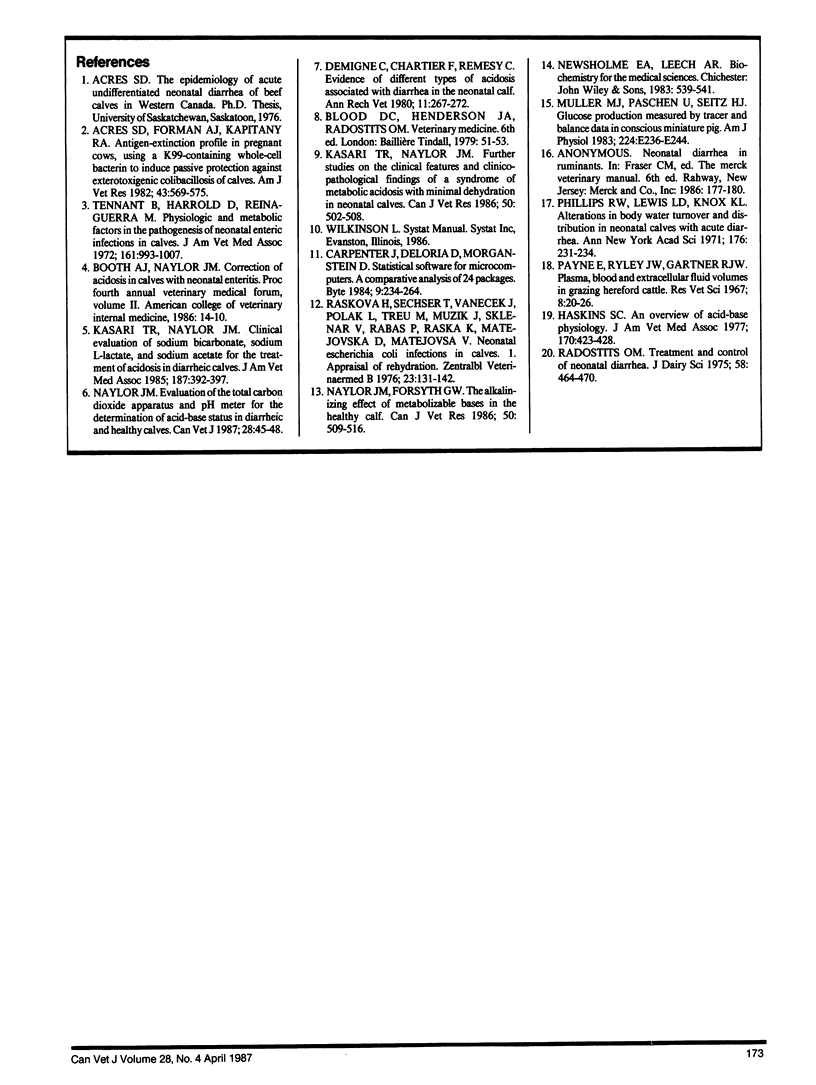Abstract
A prospective study of the severity of dehydration and acidosis was carried out in 42 calves under 35 days of age presented for treatment of neonatal diarrhea. Clinically the mean level of dehydration was 8 to 10%. The plasma volume was 65% of that in the hydrated calf but the calves only gained 6.5% in weight during therapy.
Calves under eight days of age often had a lactic acidosis. Blood pH was 7.118±0.026 (mean ± 1 standard error), bicarbonate concentration 18.8±1.3 mmol/L, base deficit 11.4±1.7 mmol/L and lactate of 3.6± 0.06 mmol/L. Calves over eight days usually had a nonlactic acidosis. Blood pH was 7.042±0.021, bicarbonate 10.8±1.0 mmol/L, base deficit 19.5±1.2 mmol/L and lactate 1.2±0.3 mmol/L. These values were all significantly different from those in younger calves.
Over all calves there was a poor correlation between the severity of acidosis and dehydration(r=0.05). The severity of lactic acidosis was related to the severity of dehydration. Mean bicarbonate requirements to correct acidosis were calculated to be 200 mmol(17 g of sodium bicarbonate)and 450 mmol(37 g of sodium bicarbonate)in calves under and over eight days of age respectively. Both groups of calves required a mean volume of 4L of fluid to correct dehydration.
Keywords: Dehydration, acidosis, neonatal diarrhea, calves
Full text
PDF





Selected References
These references are in PubMed. This may not be the complete list of references from this article.
- Acres S. D., Forman A. J., Kapitany R. A. Antigen-extinction profile in pregnant cows, using a K99-containing whole-cell bacterin to induce passive protection against enterotoxigenic colibacillosis of calves. Am J Vet Res. 1982 Apr;43(4):569–575. [PubMed] [Google Scholar]
- Demigné C., Chartier F., Rémésy C. Evidence of different types of acidosis associated with diarrhea in the neonatal calf. Ann Rech Vet. 1980;11(3):267–272. [PubMed] [Google Scholar]
- Haskins S. C. An overview of acid-base physiology. J Am Vet Med Assoc. 1977 Feb 15;170(4):423–428. [PubMed] [Google Scholar]
- Kasari T. R., Naylor J. M. Clinical evaluation of sodium bicarbonate, sodium L-lactate, and sodium acetate for the treatment of acidosis in diarrheic calves. J Am Vet Med Assoc. 1985 Aug 15;187(4):392–397. [PubMed] [Google Scholar]
- Kasari T. R., Naylor J. M. Further studies on the clinical features and clinicopathological findings of a syndrome of metabolic acidosis with minimal dehydration in neonatal calves. Can J Vet Res. 1986 Oct;50(4):502–508. [PMC free article] [PubMed] [Google Scholar]
- Müller M. J., Paschen U., Seitz H. J. Glucose production measured by tracer and balance data in conscious miniature pig. Am J Physiol. 1983 Mar;244(3):E236–E244. doi: 10.1152/ajpendo.1983.244.3.E236. [DOI] [PubMed] [Google Scholar]
- Naylor J. M., Forsyth G. W. The alkalinizing effects of metabolizable bases in the healthy calf. Can J Vet Res. 1986 Oct;50(4):509–516. [PMC free article] [PubMed] [Google Scholar]
- Payne E., Ryley J. W., Gartner R. J. Plasma, blood and extracellular fluid volumes in grazing Hereford cattle. Res Vet Sci. 1967 Jan;8(1):20–26. [PubMed] [Google Scholar]
- Radostits O. M. Treatment and control of neonatal diarrhea in calves. J Dairy Sci. 1975 Mar;58(3):464–470. doi: 10.3168/jds.S0022-0302(75)84589-9. [DOI] [PMC free article] [PubMed] [Google Scholar]
- Rasková H., Sechser T., Vanecek J., Polák L., Treu M., Muzík J., Sklenár V., Rabas P., Raska K., Matejovská D. Neonatal Escherichia coli infections in calves. I. Appraisal of rehydration. Zentralbl Veterinarmed B. 1976 Mar;23(2):131–142. doi: 10.1111/j.1439-0450.1976.tb00668.x. [DOI] [PubMed] [Google Scholar]
- Tennant B., Harrold D., Reina-Guerra M. Physiologic and metabolic factors in the pathogenesis of neonatal enteric infections in calves. J Am Vet Med Assoc. 1972 Nov 1;161(9):993–1007. [PubMed] [Google Scholar]


